Did you know that you can pickle fresh seasonal vegetables with miso? Known as Misozuke, these Japanese tsukemono pickles are among the easiest to make at home. The result is unmistakable umami that‘s so good with plain steamed rice!
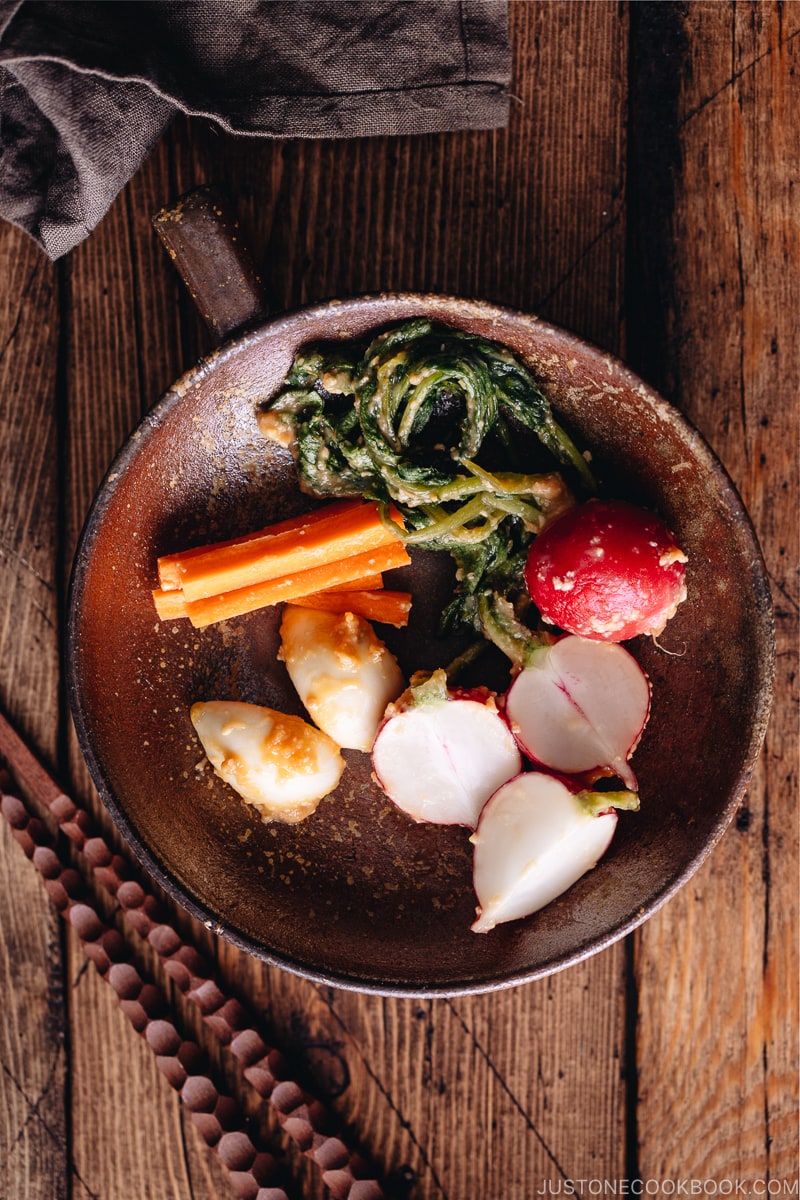
Misozuke (味噌漬け), or Japanese soybean paste (miso) pickling (zuke), is one of the easiest Japanese pickles to make. It’s simple to make miso pickles at home with miso paste, which preserves the ingredients for a long time.
Misozuke is part of my series on Japanese pickles that are known collectively as tsukemono (漬物). For a detailed introduction, please read Tsukemono: A Guide to Japanese Pickles. For today’s recipe, I’ll show you how to miso-pickle carrots and red radishes for a refreshing, crunchy side dish!
Table of Contents
What is Tsukemono?
Tsukemono or Japanese pickles are a classic side dish in a traditional Japanese meal. Some popular ones you may be familiar with include takuan (pickled daikon), umeboshi (pickled plum), gari (pickled sushi ginger), and fukujinzuke, the Japanese curry rice condiment.
Pickles are used to cleanse the palate between courses, such as pickled ginger in a sushi dinner. They help to preserve other foods, like a pickled plum tucked into a rice ball to help preserve the rice. Pickles that are crunchy also provide a textural contrast to any meal.
There are several types of tsukemono based on the pickling agent used:
- Shiozuke (塩漬け) – salt
- Suzuke (酢漬け) – rice vinegar
- Amazuzuke (甘酢漬け) – sugar and rice vinegar
- Misozuke (味噌漬け) – miso
- Shoyuzuke (醤油漬け) – soy sauce
- Kasuzuke (粕漬け) – sake kasu (lees)
- Shiokojizuke (塩麹) – rice koji/mold—cultured rice
- Nukazuke (糠漬け) – nuka (rice bran)
- Karashizuke (からし漬け) – Japanese hot mustard karashi
- Satozuke (砂糖漬け) – sugar
Today, I’ll focus on misozuke. In this recipe, we will pickle two types of vegetables—radishes and carrots.
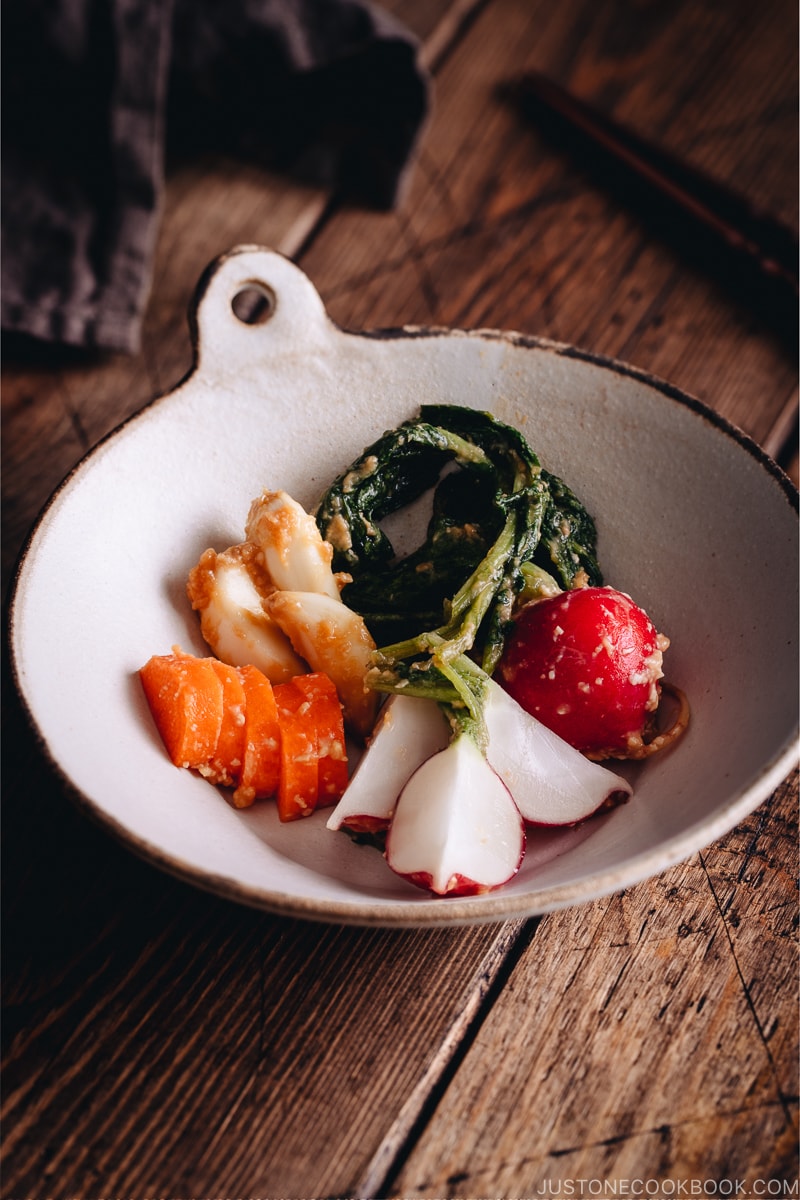
What is Misozuke?
Misozuke is pickling ingredients in a miso-based mixture. The term also refers to miso-pickled food. The pickling “marinade” is called misodoko (味噌床) and is typically a mixture of mirin, sugar, miso, and sometimes sake.
Miso-pickled vegetables are eaten as they are (raw), while miso-pickled meat and fish are baked or cooked before serving. Common ingredients for misozuke include:
- vegetables (including cucumber, carrot, burdock root, daikon, eggplant, celery)
- meat
- fish or seafood
- tofu
- cheese
- egg yolk
Ingredients for Today’s Recipe
Optional Add-ins
- piece of kombu (dried kelp) – cut into thin strips
- whole garlic cloves – you can also eat these misozuke garlic cloves after pickling!
- red chili peppers – cut into thin rounds
- knob of ginger – grated, with juice
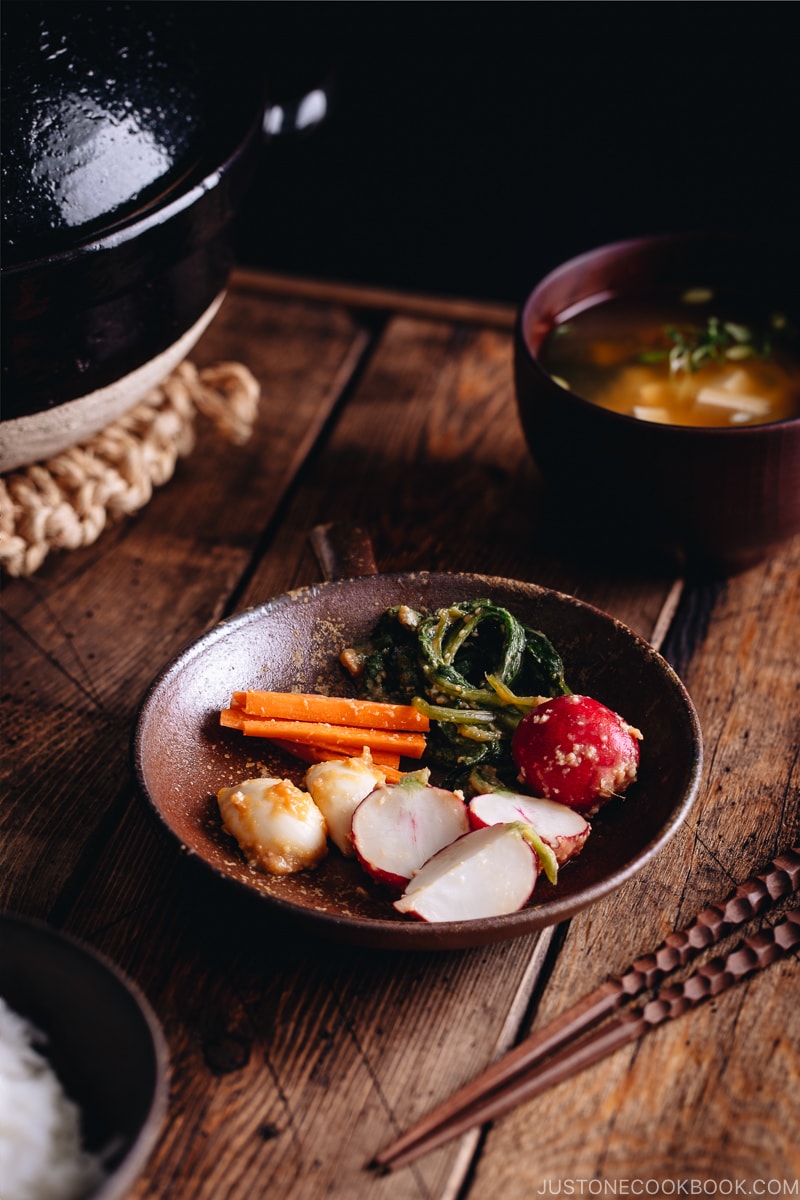
How To Pickle in Miso
- Make the misodoko (pickling marinade) by mixing the miso, mirin, and optional sugar. Make one batch per ingredient. If adding the optional kombu strips, grated ginger, or chili pepper pieces, mix them in now. I made a plain batch for the radishes and added kombu strips to the misodoko for the carrots.
- Transfer each misodoko to a resealable bag (or a glass container with lid).
- Clean and trim the radishes. I leave on the edible radish tops. Add them to the plain misodoko, remove the air, and seal the bag. Rub together through the bag to coat the radishes well.
- Peel and cut the carrots lengthwise. Add them to the misodoko with kombu strips in it. Add the optional garlic cloves, if using. Remove the air and seal the bag. Rub together from outside the bag to coat the carrots well.
- Store in the refrigerator to ferment. These ingredients are ready to eat in 2–3 hours.
- Remove the ingredients from the misodoko, wipe off the excess marinade, cut into smaller pieces, and serve.
Misozuke pickling time depends on the ingredient you’re using and ranges from 2–3 hours to 2–3 days. See the next section for more details.
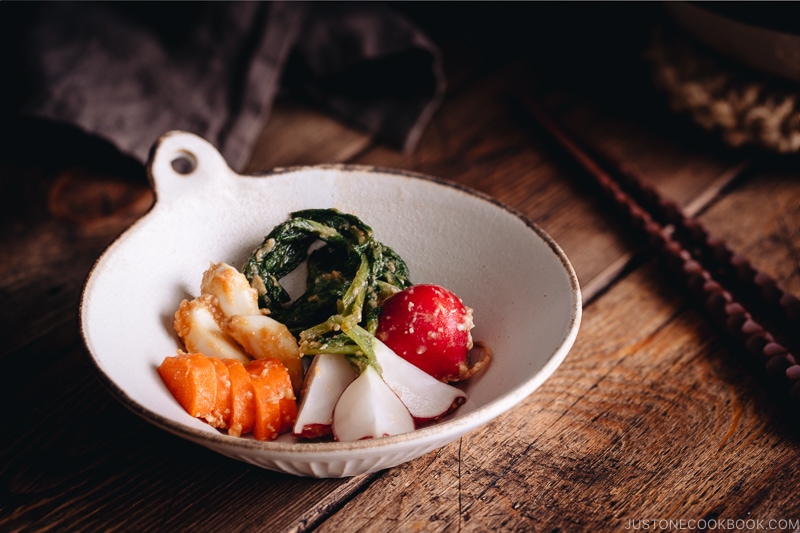
How Long To Pickle in Miso
In general, the recommended pickling time varies from 2–3 hours to half day to 2–3 days. Why such a big range? The “perfect” timing depending on the following factors:
- Salt content of the miso you use: White miso has less salt, so you may need to pickle for a longer time than red miso, which has a higher salt content.
- Type of ingredient you’re pickling: Thin and softer vegetables can pickle really fast, while thick and tough vegetables take longer. If you cut the vegetable into thinner or smaller pieces, pickling is faster.
- How you eat it: Japanese often prefer to eat something salty when eating plain steamed rice. It’s entirely up to you how salty you want your misozuke to be.
Considering the above factors, I recommend tasting your misozuke to decide on the pickling time.
Other Misozuke Tips
- Extract excess liquid from high-moisture ingredients prior to pickling to prevent mold growth, especially if you plan to marinate it for a longer time.
- Daikon radish, cucumber, and other vegetables with higher water content first must be sun-dried (one day), dried under shade (one day), or salted (either sprinkle salt or soak in salted water with 5–20% salt).
- For fish, it is best to sprinkle salt on it to draw out excess moisture before pickling.
- If you don’t plan to cook miso-pickled meat or fish within the same week, you can freeze it for a short time. It’s recommended to cook it soon, however.
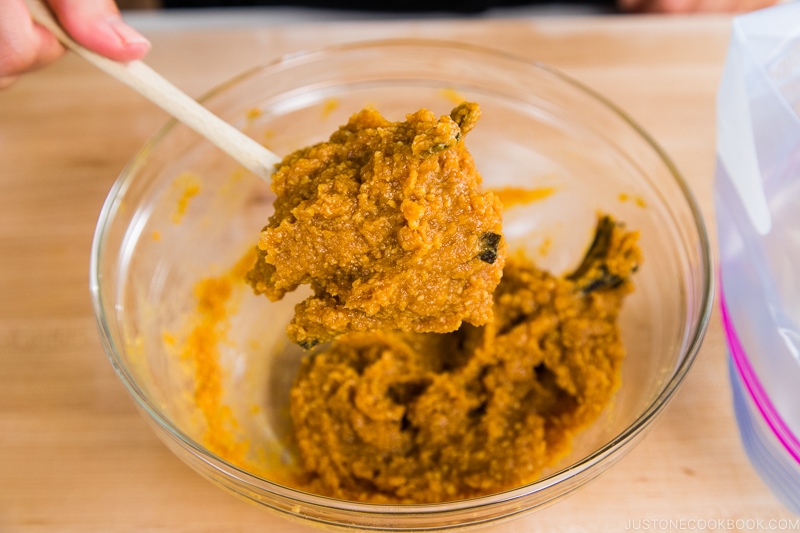
Helpful Tips for Making Misodoko
1. Separate the misodoko for vegetables and meat/fish.
For food safety, keep the pickling mixture separate for vegetables (that you eat raw) and meat/fish (that you need to cook before consuming). Or you can use new/newer misodoko for vegetables, and when it’s about to expire, use it for marinating meat and fish.
2. Use a glass container or resealable plastic bag.
A glass container works great if you plan to use the misodoko for a long time. It is easy to put in or take out the ingredients and to transfer the misodoko out of the container if you need to cook off the moisture (see next). It also keeps intact the shape of fragile ingredients (such as a thin fillet of fish).
A resealable plastic bag is good for a small amount of misozuke. Use just enough amount of misodoko to coat your ingredient and rub it against each other from outside the bag.
3. Re-use misodoko for up to 1 month.
The great thing about misodoko is that you can re-use it for up to a month! When the misodoko becomes watery from moisture released from the ingredients, all you need to do is to reheat in the pot over the stove and let the moisture evaporate. Let the misodoko cool before you use it to make Misozuke again.
4. Don’t throw away retired misodoko.
When you’re done pickling with misodoko, you can use the marinade for seasoning your stir fry dishes or as a sauce for your dish for one last time. You just need to make sure to cook the sauce.
5. Remove excess misodoko—important!
When you finish pickling meat or fish, make sure to remove any excess misodoko from the meat/fish before cooking. Miso burns easily and you do not want your dish to be charred.
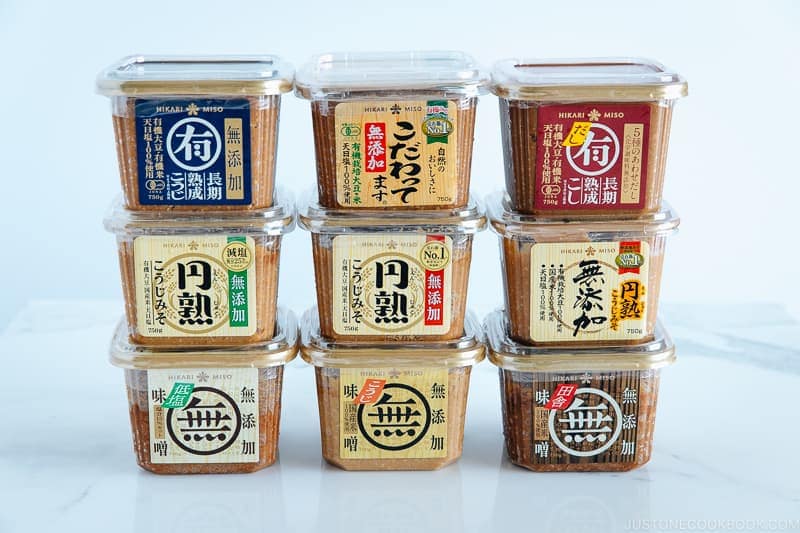
What Type of Miso To Use
Although it’s common to use bold-flavored red miso for misozuke, you can use any type of miso. Some regions in Japan use white miso for misozuke. Even red miso varies in flavor, too.
If you are new to misozuke, use the miso you have in your fridge to start. It’s the perfect way to use up leftover miso in the tub. You can read all about miso to get familiar with different types of miso.
For this recipe, I used my favorite miso, Kodawattemasu by Hikari Miso®, that I’ve been using for over a decade in my kitchen. Thank you Hikari Miso® for sponsoring this post!
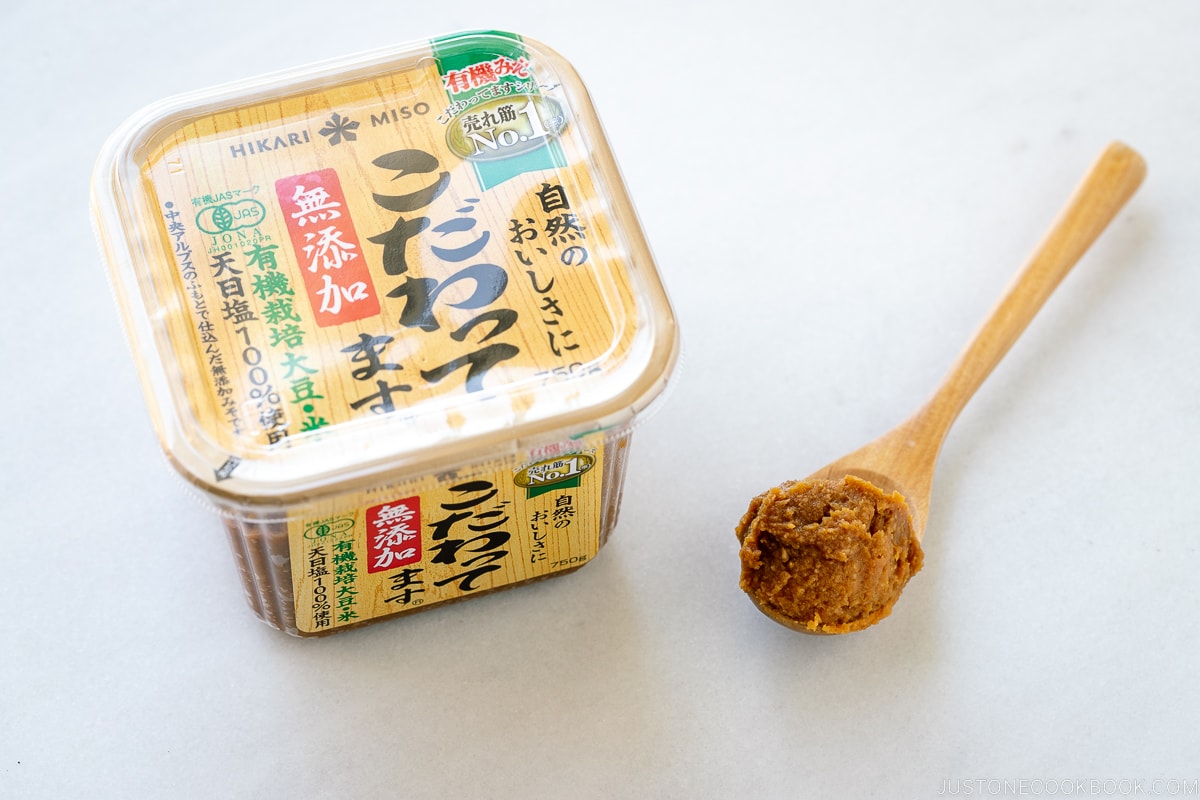
This slow-aged red koji miso is actually the #1 selling miso from Hikari Miso®. It is free of additives and preservatives, is made of organic soybeans and rice, and has a rich and mature flavor with the full-bodied umami of soybeans and the sweetness of the rice.
Where you can buy Kodawattemasu by Hikari Miso®:
- Japanese grocery stores (Nijiya, Mitsuwa, Marukai, local mom-pop shops, etc)
- Asian grocery stores (including Chinese/Korean grocery stores)
- Tokyo Central online ($7.48)
As a side note, kodawattemasu (こだわってます) in Japanese means “I’m particular (about the quality of miso and the miso-making process).” The Japanese characters may be hard to memorize, so just remember the green label with “No. 1” on the package!
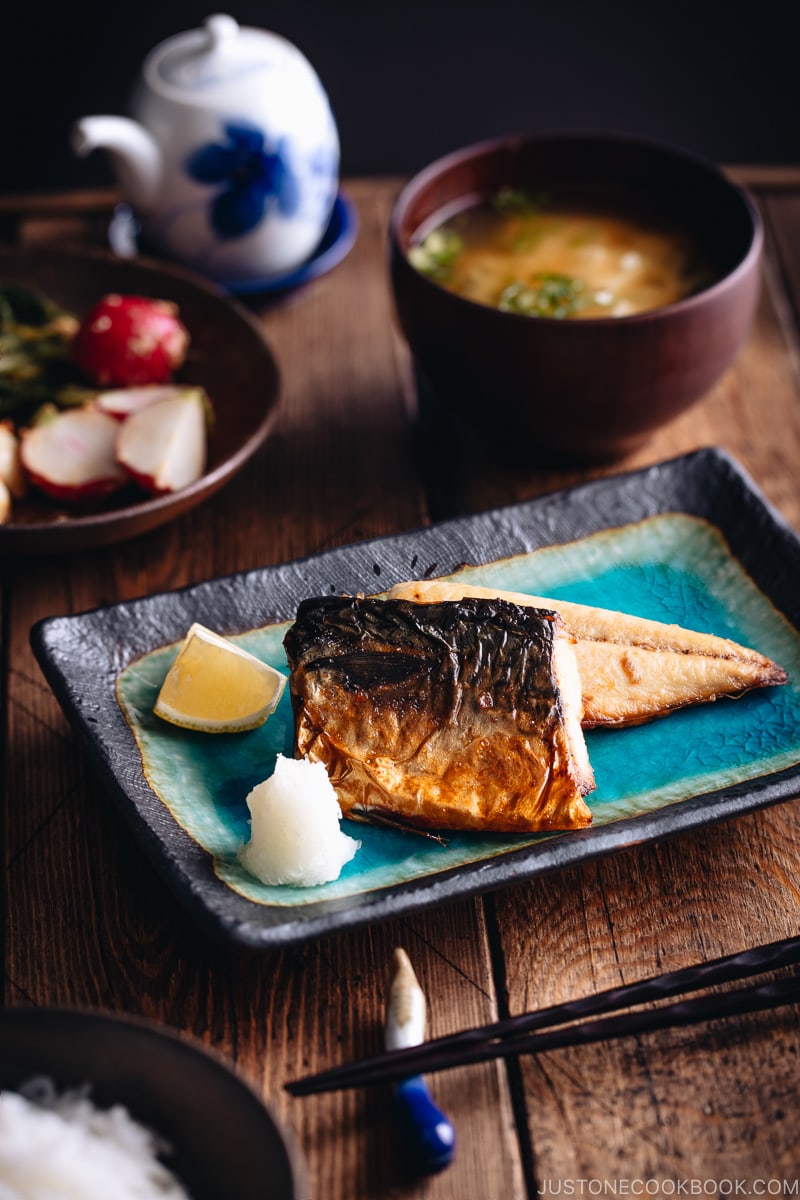
How To Enjoy Miso-Pickled Vegetables
The beauty of misozuke is you could simply enjoy the pickled foods with steamed rice. The miso pickled radishes and carrots are perfect for anyone who follows a vegetarian or vegan diet. You’ll love it with Vegan Miso Soup. Otherwise, you can serve it alongside with another protein dish such as Saba Shioyaki (Grilled Mackerel) or Seared Scallops.
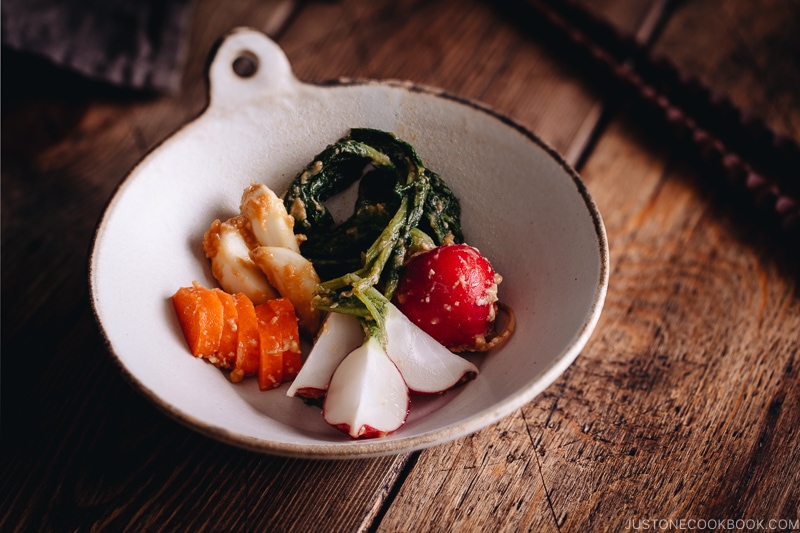
Sign up for the free Just One Cookbook newsletter delivered to your inbox! And stay in touch with me on Facebook, Pinterest, YouTube, and Instagram for all the latest updates.
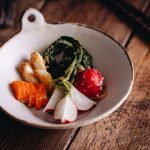
Tsukemono – Misozuke (Miso Pickling)
Ingredients
For the Misodoko Pickling "Marinade" (make one batch per ingredient)
For the Add-in Options
- 1 piece kombu (dried kelp) (4 inches, 10 cm per piece)
- 8 cloves garlic
- 1 red chili peppers
- ¼ tsp ginger (grated, with juice; from a 1-inch, 2.5-cm knob)
For the Ingredients to Pickle (read the blog post for more suggestions)
- 2 carrots (6 oz, 170 g)
- 5 red radishes (8.8 oz, 250 g)
Instructions
- Gather all the ingredients.
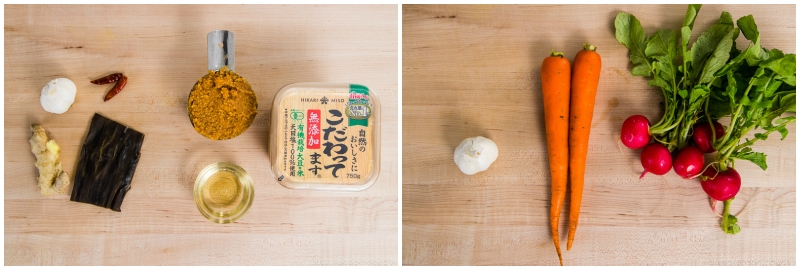
To Make the Misodoko (Pickling "Marinade")
- We make one batch of misodoko for each ingredient. For radish misozuke, we make a plain misodoko. In a medium bowl, combine 1 cup miso, 2 Tbsp mirin, and sugar (optional). Mix well.
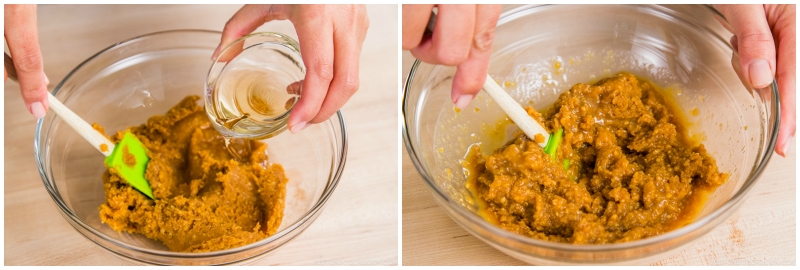
- For carrot misozuke, I add kombu and garlic cloves for additional flavor. Cut 1 piece kombu (dried kelp) into thin strips and mix it together with the misodoko. Other optional add-ins include 1 red chili peppers and ¼ tsp ginger (grated).
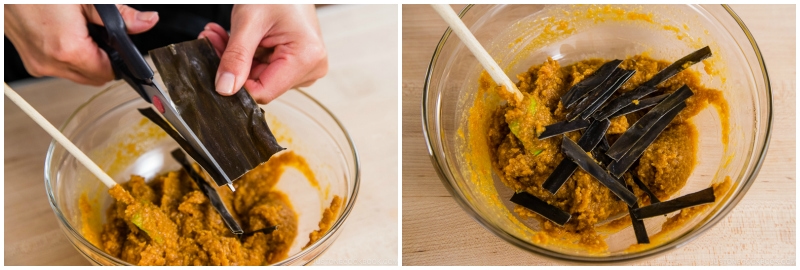
- Transfer each misodoko into a resealable bag or glass container with a lid.
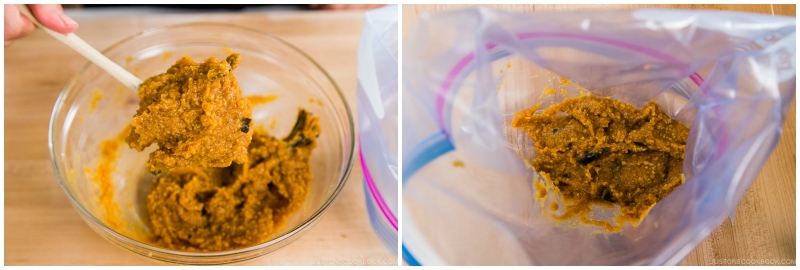
To Prepare the Vegetables
- Rinse 5 red radishes well under water. Peel 2 carrots and cut them in half lengthwise.
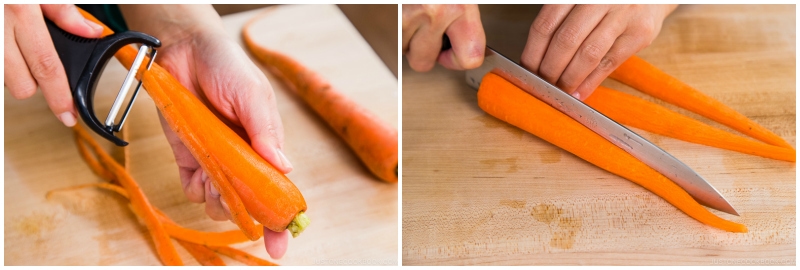
To Pickle the Vegetables
- For the radish misozuke, add the radishes to the plain misodoko in the resealable bag. Remove the air and seal the bag. Rub the radishes with the misodoko through the bag.
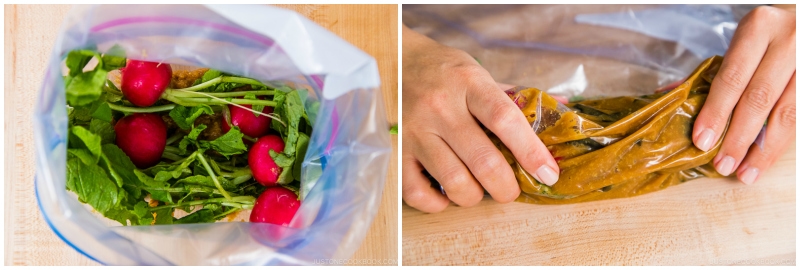
- For the carrot misozuke, add the carrots and 8 cloves garlic (peeled) to the bag with the kombu strips in it. Remove the air and seal the bag. Rub the carrots with the misodoko from outside the bag.
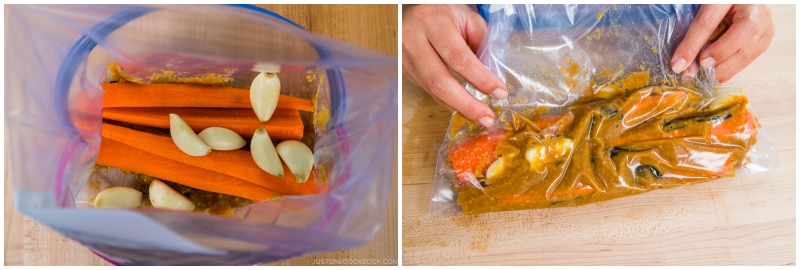
- Store in the refrigerator. Depending on the ingredients, the misozuke is ready in 2–3 hours to 2–3 days.
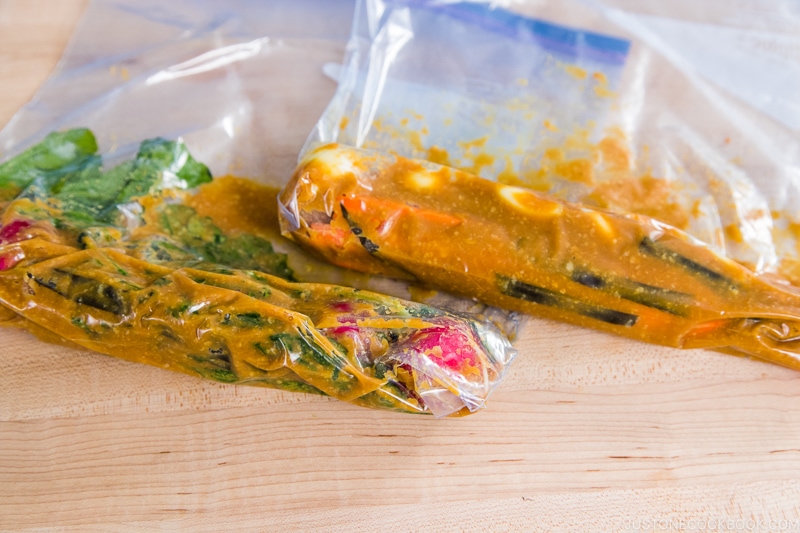
To Serve
- Remove the radishes from the misodoko, wiping off any excess miso. Cut the radishes in half and serve.

- Remove the carrots from the misodoko, wiping off any excess miso. Cut them into smaller pieces and serve.

To Reuse the Misodoko
- When you find your misodoko has some liquid in it, transfer it to a saucepan. Cook it on a low heat and let the liquid evaporate. You can reuse misodoko for up to a month. Please read the blog post for more details.
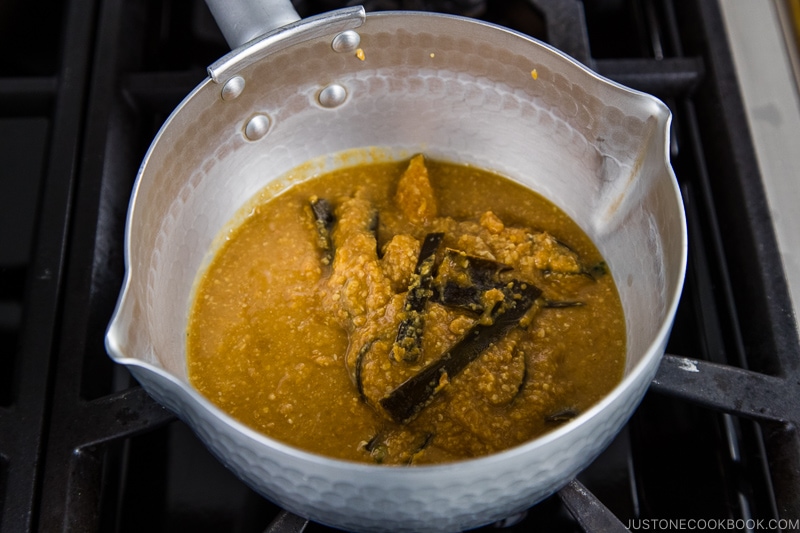
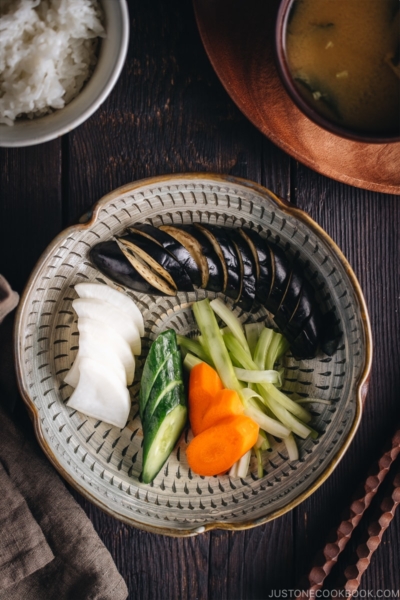
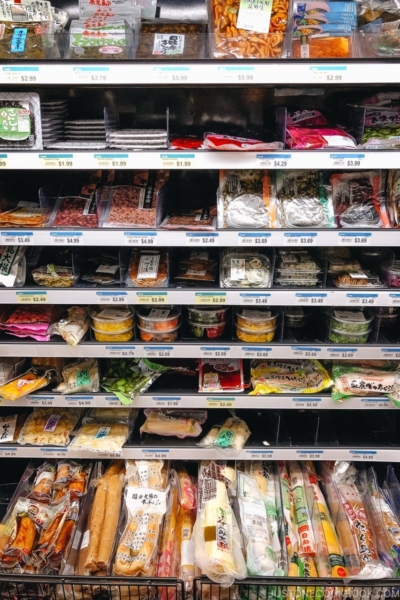
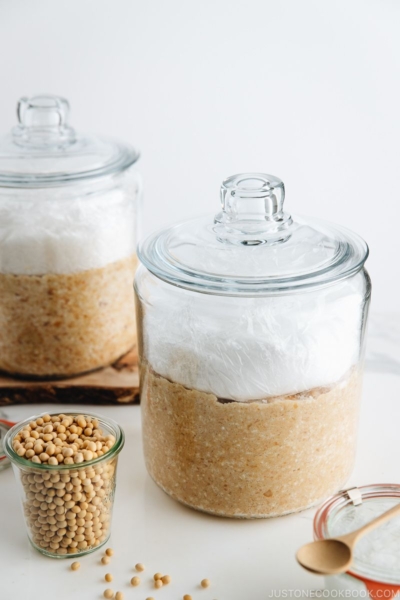
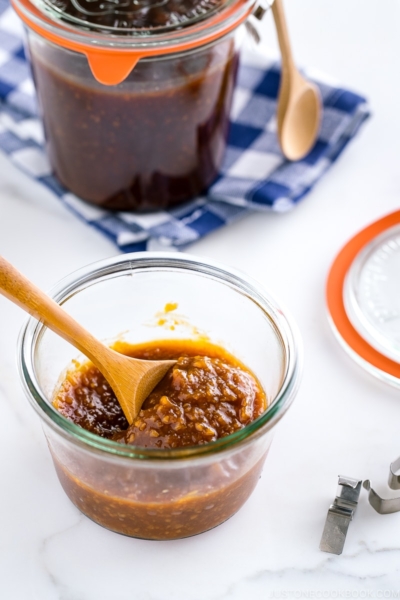
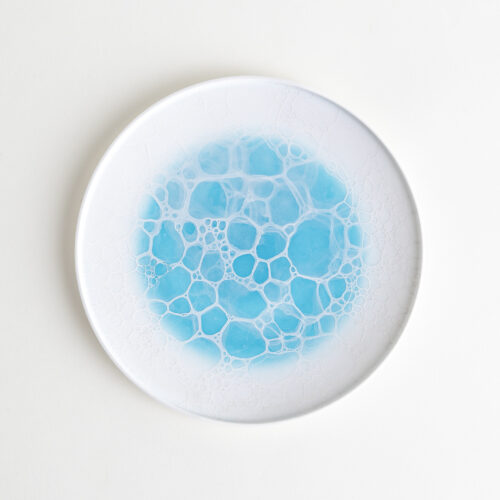
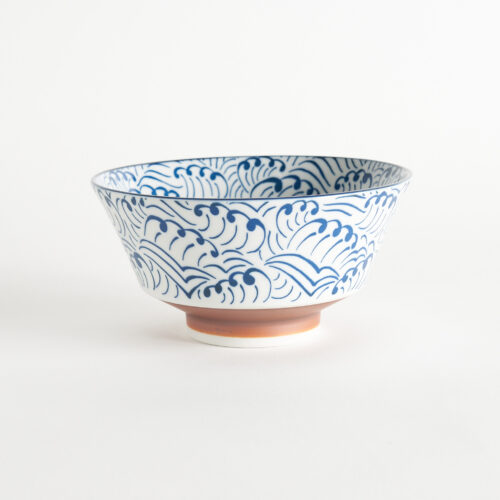
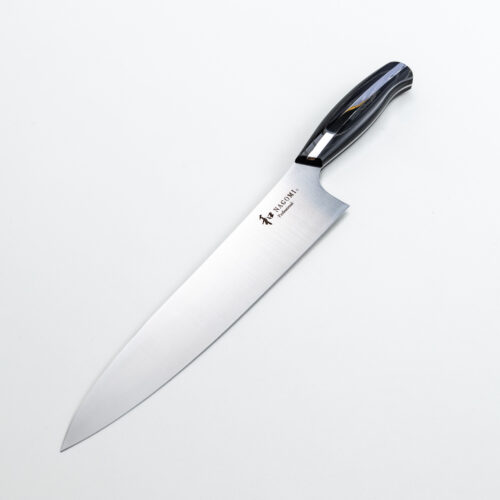
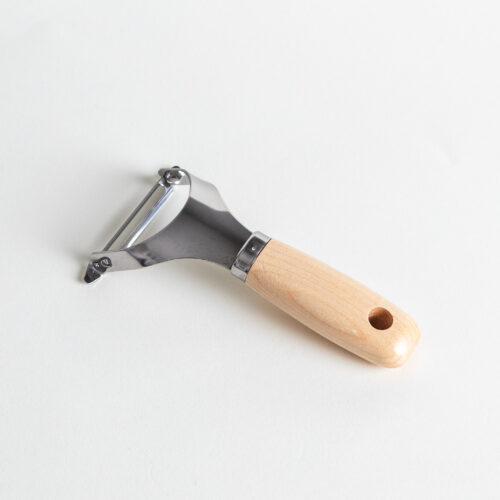
I’m looking for a long term shelf stable Japanese pickle method. What do you recommend?
Thank you,
Jim
Hello, Jim! Thank you for reading Nami’s post!
Japanese pickles with a long shelf life are typically air-dried for about a week before adding 10-20% salt. We hope this information helps!
Thank you for this series! What’s the best method for drying tofu before pickling? And then could it be eaten raw? I need a cold protein to get me through this awful Texas summer! 😀
Hello, Elaine. Thank you for taking the time to read Nami’s post and try her recipe!
We’ve never made Dried Tofu Misozuke, although you can dehydrate the tofu in the microwave. Tofu may also be frozen and dried on a rack.
We hope this was helpful!
Hi, could you recommend how long to pickle slices of avocado in white miso? I tried this really delicious pickle in Osaka and would love to try and make it. Thank you!
Hello, KayB! Thank you so much for taking the time to read Nami’s post!
Avocado can be pickled for 2-3 hours in the refrigerator or up to 1 day, depending on your liking.😉
We hope this helps!
Hi there! 🙂 Wondering if we make two batches of the misodoko? One for the carrots and one for the radishes, or if we just make the one batch with ingredients and split between them?
Hi SJ! Thank you for checking with us!
Nami prepared two batches. One cup of Misodoko for the carrots, and another cup for the radishes.
We hope you enjoy making your Tsukemono!😊
How long do I leave them cucumbers in the salt solution before I put them in the misodoko?
Hi Kay! Thank you very much for trying Nami’s recipe!
Please soak the cucumbers in the salt solution for about 2 hours, then wipe them with a clean cloth/paper towel and pickle them in the Misodoko.
We hope this helps!
Hi, I want to try this recipe but I don’t have mirin. Can I use a sweet white wine? O maybe it’s better to use water with sugar? Thanks 🙂
Hi Pam, Thank you very much for trying this recipe!
To substitute Mirin, if you have a Sake, we recommend using it mixed with sugar. The ratio of sake and sugar is 3 to 1. For example, mix ¾ cup (or 1 Tbsp) good quality drinking sake with ¼ cup (or 1 tsp) granulated sugar. Otherwise, the fragrance will be different, but sweet white wine will do the job too. We hope this helps!